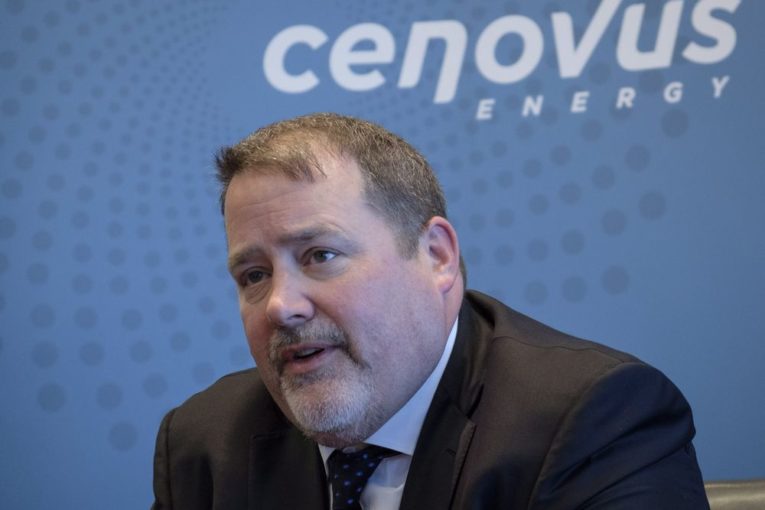
One of Canada’s largest oilsands producers is ramping up crude-by-rail shipments and slowing production amid “fire-sale” prices for Canadian crude.
But Cenovus Energy CEO Alex Pourbaix insists his company won’t carry the load for an over-supplied industry as the Canadian oilpatch is confronted with widening price discounts for its product.
And the fallout for the Alberta government could potentially be a revenue hole in the billions of dollars if the problem continues, he warned.
“The industry right now has a production problem,” Pourbaix said on a conference call Wednesday.
“We are going to do our part, but we are not going to carry the industry on our back. I think this is something that has to be dealt with on an industry-wide basis.”
Cenovus, which pumped out more than 376,000 barrels of oil per day during the third quarter, is one of many energy companies being pummelled by weak prices for oil produced in Alberta.
The discount for Western Canadian Select crude hovered above US$40 a barrel this week compared with U.S. benchmark oil prices.
At current levels, the price differential would cost the country $30 billion annually in lost revenue and economic activity, according to the Alberta government.
A lack of pipelines and full storage levels in Western Canada are triggering the steep discount, yet there are few short-term options to resolve a supply-demand imbalance of an estimated 185,000 barrels per day.
But it’s time everyone starts looking for answers, because the current situation should be untenable for industry, federal and provincial governments that are collectively losing an estimated $84 million each day.
Pourbaix pointed out the company will be strategically slowing production in the fourth quarter, leaving some bitumen barrels from its Christina Lake and Foster Creek thermal projects underground.
Cenovus has other strategies to soften the pricing blow.
It will use caverns to store up to three million barrels of oil and recently signed an agreement with major railway companies to transport about 100,000 barrels a day of heavy crude by rail, getting it to the U.S. Gulf Coast.
“We are not producing at max rates. I can only do what I can do,” Pourbaix said in an interview.
“It seems to me that ultimately this very, very small oversupply is driving an absolutely astonishing impact on the Alberta and Canadian economy, and I’d like to think we can deal with that.”
A report from RBC Capital Markets this week suggested Alberta consider a royalty holiday solution to temporarily scale back output, having companies not produce the government’s own royalty barrels to reduce the glut.
Pourbaix, who took over as CEO of Cenovus a year ago after serving as chief operating officer at TransCanada Corp., stressed the oversupply is driving a “massive destruction of value.”
Asked what the short-term solution is, Pourbaix said he’ll leave it to experts in government and industry to figure out what tools they have in their toolbox.
But the head of Cenovus said he would take a hard look at solutions that can remedy the gridlock.
“In a world where the Alberta government is going to potentially face a revenue hole in the billions of dollars in royalties — remember royalties are paid on profits, and if there are no profits, there are no royalties — this is not purely an academic exercise we are talking about,” he added.
Last week, Premier Rachel Notley pressed Ottawa to buy rail cars and locomotives to help increase transportation capacity and solve the issue.
Energy Minister Marg McCuaig-Boyd said Wednesday she hasn’t heard a clear answer yet from federal officials, but both sides and the industry are talking about market access issues.
“This is pretty complex and we’re looking at options that we have, but it’s not a decision we will make quickly, one way or the other,” she told reporters at the legislature.
The price differential has become a central focus for the government and oilpatch as the future of new pipelines remains tenuous.
Enbridge’s Line 3 project will come on stream later next year, but it’s unclear when Keystone XL or the Trans Mountain expansion projects will proceed.
Pourbaix said Canadian companies are selling crude to the U.S. at “fire-sale prices” and he believes the price discount will remain relatively high for the rest of this year and early 2019, but moderate as more oil is exported by rail.
There’s no question the pressure will build as oil production keeps increasing, and a new report from the National Energy Board on Canada’s Energy Future expects that to happen.
Under its base-case forecast of future oil production, the NEB projects prices will be high enough to increase oil output in Canada by 58 per cent to almost seven million barrels per day by 2040.
It assumes exports markets will be found for Canadian crude, while the high oil-price discount will continue in the short and medium term.
“The potential for significant energy production in Canada remains strong,” NEB chair Peter Watson said in an interview.
“We see that differential being able to be mitigated over a reasonable period of time.”
The price discount normally averages between US$10 and $15 a barrel to reflect quality differences and transportation costs to move oil to U.S. refineries.
The NEB expects short-term constraints in pipeline capacity and other factors will propel the discount to average US$26 a barrel in 2020, before gradually coming down to around $14 by 2027.
Hopefully new pipelines will be built before then and the oil industry — and the provincial government — won’t face several more years of transportation troubles.
But in the short term, it appears the fire sale on Alberta crude will continue.
Chris Varcoe is a Calgary Herald columnist.
You can read more of the news on source
